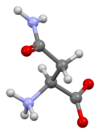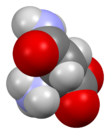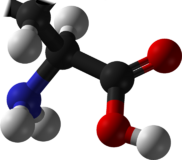Chemistry:Asparagine
 Skeletal formula of L-asparagine
| |||

| |||
|
| |||
| Names | |||
|---|---|---|---|
| IUPAC name
Asparagine
| |||
| Other names
2-Amino-3-carbamoylpropanoic acid
| |||
| Identifiers | |||
3D model (JSmol)
|
|||
| ChEBI | |||
| ChEMBL | |||
| ChemSpider | |||
| DrugBank | |||
| EC Number |
| ||
| KEGG | |||
PubChem CID
|
|||
| UNII | |||
| |||
| |||
| Properties | |||
| C4H8N2O3 | |||
| Molar mass | 132.119 g·mol−1 | ||
| Appearance | white crystals | ||
| Density | 1.543 g/cm3 | ||
| Melting point | 234 °C (453 °F; 507 K) | ||
| Boiling point | 438 °C (820 °F; 711 K) | ||
| 2.94 g/100 mL | |||
| Solubility | soluble in acids, bases, negligible in methanol, ethanol, ether, benzene | ||
| log P | −3.82 | ||
| Acidity (pKa) |
| ||
| -69.5·10−6 cm3/mol | |||
| Structure | |||
| orthorhombic | |||
| Thermochemistry | |||
Std enthalpy of
formation (ΔfH⦵298) |
−789.4 kJ/mol | ||
| Hazards | |||
| Safety data sheet | Sigma-Alrich | ||
| NFPA 704 (fire diamond) | |||
| Flash point | 219 °C (426 °F; 492 K) | ||
Except where otherwise noted, data are given for materials in their standard state (at 25 °C [77 °F], 100 kPa). | |||
| Infobox references | |||
Asparagine (symbol Asn or N[1]) is an α-amino acid that is used in the biosynthesis of proteins. It contains an α-amino group (which is in the protonated −NH+3 form under biological conditions), an α-carboxylic acid group (which is in the deprotonated −COO− form under biological conditions), and a side chain carboxamide, classifying it as a polar (at physiological pH), aliphatic amino acid. It is non-essential in humans, meaning the body can synthesize it. It is encoded by the codons AAU and AAC.
History
Asparagine was first isolated in 1806 in a crystalline form by French chemists Louis Nicolas Vauquelin and Pierre Jean Robiquet (then a young assistant). It was isolated from asparagus juice,[2][3] in which it is abundant, hence the chosen name. It was the first amino acid to be isolated.[4]
Three years later, in 1809, Pierre Jean Robiquet identified a substance from liquorice root with properties which he qualified as very similar to those of asparagine,[5] and which Plisson identified in 1828 as asparagine itself.[6][7]
The determination of asparagine's structure required decades of research. The empirical formula for asparagine was first determined in 1833 by the French chemists Antoine François Boutron Charlard and Théophile-Jules Pelouze; in the same year, the German chemist Justus Liebig provided a more accurate formula.[8][9] In 1846 the Italian chemist Raffaele Piria treated asparagine with nitrous acid, which removed the molecule's amine (–NH2) groups and transformed asparagine into malic acid.[10] This revealed the molecule's fundamental structure: a chain of four carbon atoms. Piria thought that asparagine was a diamide of malic acid;[11] however, in 1862 the German chemist Hermann Kolbe showed that this surmise was wrong; instead, Kolbe concluded that asparagine was an amide of an amine of succinic acid.[12] In 1886, the Italian chemist Arnaldo Piutti (1857–1928) discovered a mirror image or "enantiomer" of the natural form of asparagine, which shared many of asparagine's properties, but which also differed from it.[13] Since the structure of asparagine was still not fully known – the location of the amine group within the molecule was still not settled[14] – Piutti synthesized asparagine and thus published its true structure in 1888.[15]
Structural function in proteins
Since the asparagine side-chain can form hydrogen bond interactions with the peptide backbone, asparagine residues are often found near the beginning of alpha-helices as asx turns and asx motifs, and in similar turn motifs, or as amide rings, in beta sheets. Its role can be thought as "capping" the hydrogen bond interactions that would otherwise be satisfied by the polypeptide backbone.
Asparagine also provides key sites for N-linked glycosylation, modification of the protein chain with the addition of carbohydrate chains. Typically, a carbohydrate tree can solely be added to an asparagine residue if the latter is flanked on the C side by X-serine or X-threonine, where X is any amino acid with the exception of proline.[16]
Asparagine can be hydroxylated in the HIF1 hypoxia inducible transcription factor. This modification inhibits HIF1-mediated gene activation.[17]
Sources
Dietary sources
Asparagine is not essential for humans, which means that it can be synthesized from central metabolic pathway intermediates and is not required in the diet.
Asparagine is found in:
- Animal sources: dairy, whey, beef, poultry, eggs, fish, lactalbumin, seafood
- Plant sources: seaweed (spirulina), potatoes, soy protein isolate, tofu
Biosynthesis and catabolism
The precursor to asparagine is oxaloacetate, which a transaminase enzyme converts to aspartate. The enzyme transfers the amino group from glutamate to oxaloacetate producing α-ketoglutarate and aspartate. The enzyme asparagine synthetase produces asparagine, AMP, glutamate, and pyrophosphate from aspartate, glutamine, and ATP. Asparagine synthetase uses ATP to activate aspartate, forming β-aspartyl-AMP. Glutamine donates an ammonium group, which reacts with β-aspartyl-AMP to form asparagine and free AMP.[18]
In reaction that is the reverse of its biosynthesis, asparagine is hydrolyzed to aspartate by asparaginase. Aspartate then undergoes transamination to form glutamate and oxaloacetate from alpha-ketoglutarate. Oxaloacetate, which enters the citric acid cycle (Krebs cycle).[18]
Acrylamide controversy
Heating a mixture of asparagine and reducing sugars or other source of carbonyls produces acrylamide in food. These products occur in baked goods such as French fries, potato chips, and toasted bread. Acrylamide is converted in the liver to glycidamide, which is a possible carcinogen.[19]
Function
Asparagine synthetase is required for normal development of the brain.[20] Asparagine is also involved in protein synthesis during replication of poxviruses.[21]
The addition of N-acetylglucosamine to asparagine is performed by oligosaccharyltransferase enzymes in the endoplasmic reticulum.[22] This glycosylation is involved in protein structure[23] and function.[24]
References
- ↑ "Nomenclature and Symbolism for Amino Acids and Peptides". IUPAC-IUB Joint Commission on Biochemical Nomenclature. 1983. http://www.chem.qmul.ac.uk/iupac/AminoAcid/AA1n2.html.
- ↑ "La découverte d'un nouveau principe végétal dans le suc des asperges" (in fr). Annales de Chimie 57: 88–93. 1806.
- ↑ The chemical composition of the proteins. Monographs on biochemistry. Part I. Analysis (2nd ed.). London: Longmans, Green and Co.. 1912. p. 112. https://books.google.com/books?id=7JM8AAAAIAAJ&pg=PA112. Retrieved January 18, 2010.
- ↑ Advances in Protein Chemistry. New York: Academic Press. 1972. pp. 99, 103. ISBN 978-0-12-034226-6. https://archive.org/details/advancesinprotei26anfi/page/99.
- ↑ "Analyse de la racine de réglisse" (in fr). Annales de Chimie et de Physique 72 (1): 143–159. 1809. https://babel.hathitrust.org/cgi/pt?id=mdp.39015065225404;view=1up;seq=143.
- ↑ "De l'indentité de l'asparagine avec l'agédoïte" (in fr). Journal de Pharmacie et des Sciences Accessoires 14 (4): 177–182. 1828. https://books.google.com/books?id=ELgal5J1G5AC&pg=PA177.
- ↑ Felter, Harvey Wickes; Lloyd, John Uri (1898). "Glycyrrhiza (U. S. P.)—Glycyrrhiza". King's American Dispensatory. Henriette's Herbal Homepage. http://www.henriettes-herb.com/eclectic/kings/glycyrrhiza.html.
- ↑ Boutron-Charlard; Pelouze (1833). "Ueber das Asparamid (Asparagin des Herrn Robiquet) und die Asparamidsäure" (in de). Annalen der Chemie 6: 75–88. doi:10.1002/jlac.18330060111. https://babel.hathitrust.org/cgi/pt?id=uva.x002457885;view=1up;seq=467. The empirical formula of asparagine appears on p. 80.
- ↑ Liebig, Justus (1833). "Ueber die Zusammensetzung des Asparamids und der Asparaginsäure" (in de). Annalen der Chemie 7 (14): 146–150. doi:10.1002/andp.18341071405. Bibcode: 1834AnP...107..220L. https://babel.hathitrust.org/cgi/pt?id=uva.x002457886;view=1up;seq=156. The empirical formula appears on p. 149 ; the formula is correct if the subscripts are divided by 2.
- ↑ See:
- Piria, Raffaele (January 1846). "Studi sulla costituzione chimica dell' asparagina e dell' acido aspartico" (in it). Il Cimento 4: 55–73. doi:10.1007/BF02532918. https://books.google.com/books?id=5ptZAAAAYAAJ&pg=PA55.
- French translation: Piria, Raffaele (1848). "Recherches sur la constitution chimique de l'asparagine et de l'acide aspartique" (in fr). Annales de Chimie et de Physique. 3rd series 22: 160–179. https://babel.hathitrust.org/cgi/pt?id=hvd.hx3dy1;view=1up;seq=164. From p. 175: " … on voit, en outre, que l'asparagine et l'acide aspartique lui-même se décomposent avec une facilité remarquable, sous l'influence de l'acide hyponitrique, en fournissant du gaz azote et de l'acide malique." ( … one sees, in addition, that asparagine and aspartic acid itself are decomposed with a remarkable ease under the influence of nitrous acid, rendering nitrogen gas and malic acid.)
- ↑ Plimmer, Robert Henry Aders (1912). The Chemical Constitution of the Proteins. Part I: Analysis (2nd ed.). London, England: Longmans, Green and Co.. p. 112. https://books.google.com/books?id=EaAhAQAAMAAJ&pg=PA112.
- ↑ Kolbe, Hermann (1862). "Ueber die chemische Constitution des Asparagins und der Asparaginsäure" (in de). Annalen der Chemie 121 (2): 232–236. doi:10.1002/jlac.18621210209. https://babel.hathitrust.org/cgi/pt?id=uva.x002457960;view=1up;seq=244.
- ↑ "Ein neues Asparagin" (in de). Berichte der Deutschen Chemischen Gesellschaft 19 (2): 1691–1695. 1886. doi:10.1002/cber.18860190211. https://babel.hathitrust.org/cgi/pt?id=osu.32435060218146;view=1up;seq=903.
- ↑ The French chemist Edouard Grimaux thought that the amine group (–NH2) was located next to the amide group (–C(O)NH2), whereas the Italian chemist Icilio Guareschi thought that the amine group was located next to the carboxyl group (–COOH).
- Grimaux, Edouard (1875). "Recherches synthétiques sur le groupe urique" (in fr). Bulletin de la Société Chimique de Paris. 2nd series 24: 337–355. https://babel.hathitrust.org/cgi/pt?id=hvd.hc1j15;view=1up;seq=345. On p. 352, Grimaux presented two putative structures for asparagine, and on p. 353, he favored structure (I.), which is incorrect. From p. 353: " … ce sont les formules marquées du chiffre I qui me semblent devoir être adoptées pour l'asparagine, … " ( … it is the formulas marked by the figure I which, it seems to me, should be adopted for asparagine, … )
- Guareschi, Icilio (1876). "Studi sull' asparagine e sull' acido aspartico" (in it). Atti della Reale Academia del Lincei. 2nd series 3 (pt. 2): 378–393. https://babel.hathitrust.org/cgi/pt?id=mdp.39015080328845;view=1up;seq=406. On p. 388, Guareschi proposed two structures (α and β) for asparagine; he favored α, the correct one. From p. 388: "La formola α mi sembra preferibile per seguente ragione: … " (The formula α seems preferable to me for the following reason: … )
- English abstract in: "Asparagine and aspartic acid". Journal of the Chemical Society 31: 457–459. 1877. https://babel.hathitrust.org/cgi/pt?id=chi.47400175;view=1up;seq=473. See especially p. 458.
- ↑ "Sintesi e costituzione delle asparagine" (in it). Gazzetta Chimica Italiana 18: 457–472. 1888. https://babel.hathitrust.org/cgi/pt?id=mdp.39015036973934;view=1up;seq=471.
- ↑ Brooker, Robert; Widmaier, Eric; Graham, Linda; Stiling, Peter; Hasenkampf, Clare; Hunter, Fiona; Bidochka, Michael; Riggs, Daniel (2010). "Chapter 5: Systems Biology of Cell Organization". Biology (Canadian ed.). United States of America: McGraw-Hill Ryerson. pp. 105–106. ISBN 978-0-07-074175-1.
- ↑ "FIH-1 is an asparaginyl hydroxylase enzyme that regulates the transcriptional activity of hypoxia-inducible factor". Genes & Development 16 (12): 1466–71. June 2002. doi:10.1101/gad.991402. PMID 12080085.
- ↑ 18.0 18.1 Berg, Jeremy; Tymoczko, John; Stryer, Lubert (2002). Biochemistry (5th ed.). New York: W. H. Freeman. p. 968. ISBN 0716746840. https://www.ncbi.nlm.nih.gov/books/bv.fcgi?call=bv.View..ShowTOC&rid=stryer.TOC. Retrieved 27 May 2021.
- ↑ Friedman, Mendel (2003). "Chemistry, Biochemistry, and Safety of Acrylamide. A Review". Journal of Agricultural and Food Chemistry 51 (16): 4504–4526. doi:10.1021/jf030204+. PMID 14705871.
- ↑ "Deficiency of asparagine synthetase causes congenital microcephaly and a progressive form of encephalopathy". Neuron 80 (2): 429–41. October 2013. doi:10.1016/j.neuron.2013.08.013. PMID 24139043.
- ↑ "Asparagine Is a Critical Limiting Metabolite for Vaccinia Virus Protein Synthesis during Glutamine Deprivation". Journal of Virology 93 (13): e01834–18, /jvi/93/13/JVI.01834–18.atom. July 2019. doi:10.1128/JVI.01834-18. PMID 30996100.
- ↑ "The dolichol pathway of N-linked glycosylation". Biochimica et Biophysica Acta (BBA) - General Subjects 1426 (2): 239–57. January 1999. doi:10.1016/S0304-4165(98)00127-5. PMID 9878760.
- ↑ "Effect of N-linked glycosylation on glycopeptide and glycoprotein structure". Current Opinion in Chemical Biology 3 (6): 643–9. December 1999. doi:10.1016/S1367-5931(99)00021-6. PMID 10600722.
- ↑ "Metabolic mimics: the disorders of N-linked glycosylation". Seminars in Pediatric Neurology 12 (3): 144–51. September 2005. doi:10.1016/j.spen.2005.10.002. PMID 16584073.
External links
 |






